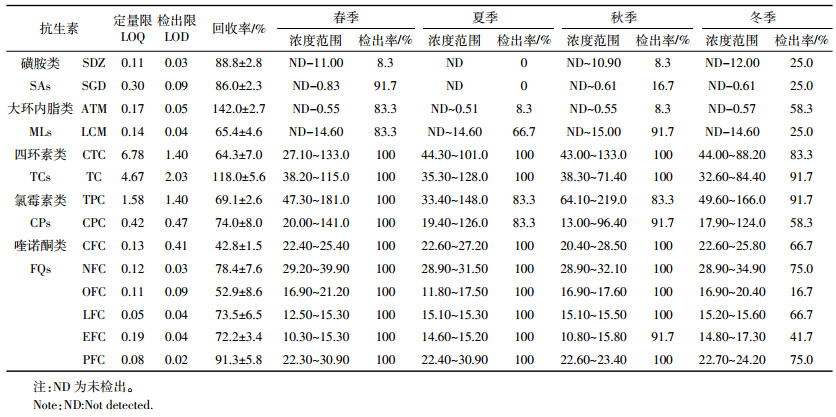文章信息
- 纵亚男, 邵美玲, 梁梦琦, 唐剑锋, 王瑞杰
- ZONG Ya-nan, SHAO Mei-ling, LIANG Meng-qi, TANG Jian-feng, WANG Rui-jie
- 长三角某城镇典型小流域水体抗生素的污染分布特征
- Occurrence and distribution of antibiotics in the surface water of a typical urban river in the Yangtze River Delta
- 农业环境科学学报, 2018, 37(5): 965-973
- Journal of Agro-Environment Science, 2018, 37(5): 965-973
- http://dx.doi.org/10.11654/jaes.2017-1445
文章历史
- 收稿日期: 2017-10-24
- 录用日期: 2017-12-19
2. 中国科学院城市环境研究所城市环境与健康重点实验室, 福建 厦门 361000;
3. 中国科学院宁波城市环境观测研究站, 浙江 宁波 315800
2. Key Laboratory of Urban Environment and Health, Institute of Urban Environment, Chinese Academy of Sciences, Xiamen 361000, China;
3. Ningbo Urban Environment Observation and Research Station, Chinese Academy of Sciences, Ningbo 315800, China
抗生素是微生物(包括细菌、真菌、放线菌属)或高等植物在生活过程中所产生的具有抗病原体或其他活性的一类次级代谢产物, 能干扰其他生活细胞发育功能的化学物质[1]。近年来, 随着城市化和工业化的快速进程, 抗生素的生产和使用量在多个国家呈现出逐年增长的趋势[2]。抗生素可以通过各种途径进入水体环境, 对生态系统和人类健康造成威胁, 引起了公众的广泛关注。研究表明, 水环境中微量水平的抗生素就会对生态环境安全和人体健康产生威胁[3-5]。抗生素在地表水中的污染已相当普遍, 如美国境内139条河流[6]和澳大利亚城市污水[7]调查结果显示其抗生素最高浓度分别达到1.90 μg·L-1和64.0 μg·L-1。国内对水环境中抗生素的浓度也有报道, 例如对汪洋河[8]、九龙江[9-10]、珠江流域[11]中抗生素的研究结果显示, 抗生素的最高浓度均在μg·L-1级别; 在太湖[12]中检测出的13种抗生素, 其最高浓度为4.72 μg·L-1; 对黄浦江[13]、黄河[14]、长江口[15]等地表水中抗生素的调查结果显示, 浓度范围在ng·L-1至μg·L-1级。此外, 国内对于城镇流域水体中抗生素的浓度也有报道, 例如对北京、常州、深圳、杭州城市河流的研究[16-18]。
中国是世界上最大的抗生素生产国和消费国, 2013年全国抗生素总使用量达到92 700 t, 抗生素不能被人体和动物完全吸收, 其中有54 000 t抗生素随粪便和尿液排出体外, 最终进入到环境中[2]。在过去的30年中, 我国城市化和工业化进程明显加快, 城市化率由1980年的19.4%增加到2011年的51.3%, 但城市化过程中不可避免地会造成污染物排放[19]。关于抗生素在流域水体中的浓度与城市化的关系已有部分报道[20-22], 例如Sun等[23]研究了厦门市不同城市化梯度中污水处理厂污水中抗生素的浓度, 结果表明, 城市中污水抗生素的浓度要显著高于郊区。而Dai等[24]对北京不同城市化梯度两条河流水体抗生素的浓度研究结果则表明, 城市化程度较低的郊区河流中抗生素浓度反而显著高于城市化较高的城市河流中浓度。因此, 关于城镇流域水体抗生素与城市化的关系还需进一步研究。本研究对长三角宁波市北仑区某城镇典型小流域(具有典型城市化梯度)抗生素的污染特征(包括季节和空间变化)进行调查研究, 揭示抗生素在城镇典型小流域的分布规律及污染现状, 探究其可能的来源与风险。
1 材料与方法 1.1 区域概况芦江位于浙江省宁波市北仑区柴桥镇, 主河道总长约9 km, 是柴桥镇境内最重要的排水河道。整个流域共包含了里隘河、洪溪河、柴桥河、东直河等4条支流, 主河道是南北流向的芦江大河, 具体分布详见图 1。柴桥街道占地总面积为65.20 km2, 有34个行政村和4个社区居委会, 人口总数为4.10万人。柴桥街道工业发展主要以不锈钢产品、铝合金板、轻工机械、系列气动工具等为主, 农业发展主要以种植花卉为主。2016年北仑区生产总值达到了1153亿元, 全年财政总收入为402.3亿元, 一般公共预算收入为207.4亿元, 比2015年增长了16.4%。688家规模以上工业企业实现工业总产值达到3238亿元, 五年累计实现工业利润824.0亿元, 占全市总量的近1/4(宁波市北仑区统计局:http://tjj.bl.gov.cn/tjsj_1.aspx)。
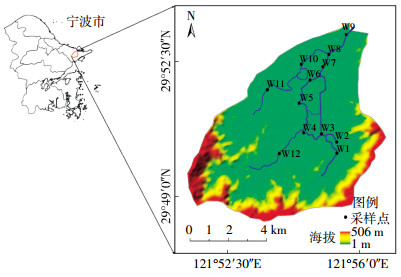
|
| 图 1 芦江流域样点分布图 Figure 1 Distribution of sampling sites in Lujiang River watershed |
根据芦江流域分布特征设置具有代表性的采样点, 分别为:以种植花木为主的农业区(W1, W2, W3, W4, W12);生活区(W5, W6, W7, W9, W10);以销售气动工具、塑料制品制造与加工、防腐阀门和防腐管道生产与销售为主的工业区(W8, W11)。此外, W4位于芦江大河和里隘河交汇处, 汇集了W3、W12两个样点所在支流的来水, W1、W2、W4和W12等样点周边有较大面积的居民区。W6位于芦江大河和柴桥河的交汇处, 以W5和W11的来水和生活污水为主, W9一侧为山体, 另一侧为生活区, W10紧挨居民区。W8位于芦江大河与东直河的交汇处, 除上游来水以外, 有大量工业废水排放。W11附近有部分农田。本研究于3月(春季)、6月(夏季)、9月(秋季)和12月(冬季)进行水样采集。每个采样点采集水样1 L, 采集的水样在当天进行过滤和固相萃取等前处理。
1.2 实验材料实验试剂:丙酮(分析纯, Tedia公司, 美国), 甲醇(分析纯, 德国), 乙酸(分析纯, 中国), 甲酸(分析纯, J & K科学有限公司), 乙二胺四乙酸二钠(分析纯, 中国)。实验用水为超纯水。阿奇霉素(ATM)、吉他霉素(LCM)、红霉素(ETM)、克拉霉素(CTM)、罗红霉素(RTM)、泰乐菌素(TLS)、林可霉素(LIM)、金霉素(CTC)、四环素(TC)、甲砜霉素(TPC)、氯霉素(CPC)、环丙沙星(CFC)、诺氟沙星(NFC)、氧氟沙星(OFC)、洛美沙星(LFC)、恩氟沙星(EFC)、培氟沙星(PFC)、磺胺嘧啶(SDZ)、磺胺脒(SGD)、磺胺二甲基(SMZ)、磺胺甲噁唑(SMX)、磺胺喹噁啉(SQX)、磺胺氯哒嗪(SCP)、磺胺噻唑(STZ)、磺胺间甲氧(SMM)、磺胺对甲氧(SM)、磺胺氯吡嗪(SCZ)、磺胺地索辛(SDM)、甲氧苄啶(TMP)等标准品均购置于美国Sigma-Aldrich公司。
实验仪器:超高效液相串联三重四极杆质谱仪(ABI 3200 Q TRAP, 美国); 24孔固相萃取仪(Waters公司, 美国); N-EVAPTM 111氮吹浓缩仪(Berlin, 美国); Oasis HLB小柱(6 cc/500 mg, Waters公司, 美国); Millio-Q纯水仪(中国); pH计(FE20K, 梅特勒-托利多上海仪器有限公司); 多参数数字化分析仪(HQ40D, 哈希, 美国)。
1.3 样品的前处理方法样品前处理方法参照Zhang等[25]方法, 具体方法如下:(1)采集回来的水样, 用直径为47 mm的滤膜进行过滤, 目的是去除水中悬浮颗粒物; (2)用10%乙酸调pH值至3.0, 向水样中分别加入0.2 g Na4EDTA· 2H2O并混匀; (3)Oasis HLB小柱分别用6 mL丙酮、6 mL甲醇、6 mL乙酸铵和6 mL超纯水进行活化; (4)水样以5 mL·min-1的流速通过Oasis HLB小柱进行萃取富集; (5)富集完成后, Oasis HLB小柱在氮气下干燥0.5 h; (6)用6 mL甲醇进行缓慢洗脱, 收集洗脱液于10 mL玻璃离心管中, 氮吹至近干(温度 < 30℃); (7)用20%甲醇溶液把已完成氮吹的样品定容至1 mL, 用0.2 μm针式滤器转移至2 mL琥珀瓶中等待分析。所有样品的前处理最好在48 h内完成。
1.4 仪器分析用超高效液相串联三重四极杆质谱仪对样品进行分析。色谱条件:采用Inertsil® ODS-SP液相色谱柱(4.60 mm×150 mm, 5 μm), 柱子温度为40℃; 进样量为20 μL; 流动相A为甲醇, B为5 mmol·L-1乙酸铵的0.1%甲酸水溶液; 流速为1 mL·min-1。质谱条件:采用LC-MS/MS的多反应监测(MRM)模式。ESI电离源, 离子源I(GS1)和II(GS2)气流量分别为50 mL·min-1和60 mL·min-1, 电离电压5500 V, 辅助加热气温度550℃。
1.5 质量控制采用外标法定量, 使用一系列的浓度梯度标准曲线(30、70、100、150、200、300 ng·L-1), 保证标准曲线每个点的实际值与其理论值之间的偏差不超过15.0%。实验以3倍信噪比为检出限, 10倍信噪比为定量限。水体中抗生素的检出限为0.02~2.03 ng·L-1, 定量限为0.05~6.78 ng·L-1, 具体见表 1。为了检验该方法的准确性, 按照样品的前处理方法, 对河水样品进行加标回收实验。SAs抗生素回收率为40.6%~106%;TCs抗生素回收率为64.3%~118%, CPs抗生素回收率为69.1%~74.0%, MLs抗生素回收率为59.0%~145%, FQs抗生素回收率为42.8%~91.3%。
结果表明, 芦江流域12个样点共检测到14种抗生素, 分别为SDZ、SGD、ATM、LCM、CTC、TC、TPC、CPC、CFC、NFC、OFC、LFC、EFC、PFC。其中, 两种TCs抗生素CTC和TC的检出率分别为95.8%和97.9%。两种CPs抗生素TPC和CPC的检出率分别为89.6%和83.3%。6种FQs抗生素CFC、NFC、OFC、LFC、EFC、PFC的检出率较高, 检出率分别为91.7%、93.8%、79.2%、91.7%、83.4%和93.8%。而MLs和SAs抗生素的检出率较低, 仅LCM的检出率大于50.0%, 其他3种抗生素的检出率都在50.0%以下。不同种类抗生素的检出率差异可能与其使用量、使用方式以及环境行为的差异有关。
由表 1可知, 可检出的抗生素浓度均在ng·L-1级别。芦江流域中CPs抗生素的浓度范围为13.00~219.0 ng·L-1; TCs抗生素的浓度范围为27.10~133.0 ng·L-1。而FQs、MLs和SAs三类抗生素的检出浓度较低, 浓度范围分别为10.30~39.90、ND~15.00 ng·L-1和ND~12.00 ng·L-1。从浓度的平均值来看, TPC浓度最高, 为104.2 ng·L-1, 其次为CPC, 其平均浓度达到76.30 ng·L-1。TCs抗生素的浓度仅次于CPs, CTC和TC两种抗生素的浓度平均值分别为69.50 ng·L-1和57.70 ng·L-1。6种FQs抗生素中, NFC的浓度最高, 为30.80 ng·L-1, CFC和PFC的浓度相同, 均为23.70 ng·L-1, 其余3种抗生素的平均浓度均低于20.00 ng·L-1。MLs、SAs平均浓度较低, 不超过10.00 ng·L-1。MLs和SAs抗生素平均浓度大小为LCM>SDZ>SGD>ATM。
国内外其他流域水体抗生素浓度如表 2所示。研究结果表明, 芦江流域内TCs抗生素CTC浓度低于国内九龙江和汪洋河, 以及国外澳大利亚城市用水和美国139条溪流等流域, 而TC浓度与黄浦江浓度接近, 但高于海河流域[26]和长江流域, 远低于北京温榆河、清凉河和凉水河。对于CPs抗生素, 芦江流域中TPC的平均浓度与长江流域[26]浓度相近, 而CPC平均浓度高于黄浦江和北运河[27], 约为长江和珠江的7倍。CPC通常用于食品添加过程, 目前多个国家已经严格禁止, 但由于其价格低廉和抗菌效果稳定等特点, 其被非法用于家畜和水产养殖的现象依然存在[28-29]。芦江流域该类抗生素浓度高可能是因为流域内水产养殖而导致水体中该抗生素浓度较高。芦江流域水体中FQs抗生素检出率高, 检出浓度低, 最高检出浓度为39.90 ng·L-1, 低于杭州和临安等处于较高城市化水平的流域。SAs抗生素在芦江流域中的检出率和检出浓度较低, 最高检出浓度为12.00 ng·L-1, 远低于黄浦江和长江流域。相比于小清河流域中MLs抗生素浓度, 芦江流域中MLs抗生素浓度处于低水平。与国内外流域抗生素浓度对比, 芦江流域中除了CPC浓度处于高水平状态, 其余抗生素浓度处于低水平状态。
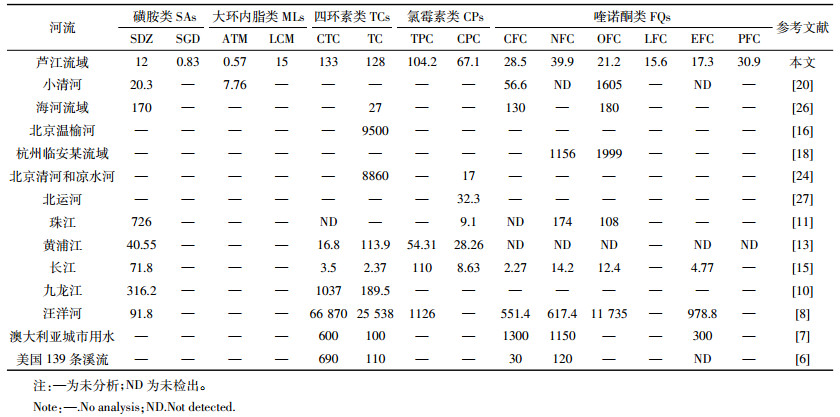
|
芦江流域抗生素检出率春季(90.5%)和秋季(78.0%)高于夏季(74.4%)和冬季(57.2%), 与珠江[30]的研究结果相一致。春季抗生素检出浓度和检出率高, 表明在低流速和低温条件下抗生素残留量高于高流速和高温条件下[11, 13, 21]。MLs和SAs抗生素在四季中浓度变化范围较大, CPs、TCs、FQs抗生素变化幅度较小, 表明各类抗生素受季节变化影响不同。
研究表明, 降雨、光照强度、温度、微生物活性等都是使抗生素浓度在不同季节发生变化的原因[9, 31-32]。SAs抗生素易被生物降解, 夏季高温会增加微生物的活性, 加速SAs抗生素的降解[33]。因此芦江流域四季中SAs抗生素浓度变化较大的原因, 可能是四季不同光照强度、温度、降雨量等导致的。MLs抗生素是一类具有大量立体异构体的复杂大型分子, 广泛应用于人类[34-35]。它本身的疏水性和对土壤、沉积物的吸附力, 使得其在水环境中的浓度较低[36]。而芦江流域中MLs抗生素浓度在四季中变化较大的原因, 可能是因为春季和冬季疾病多发, 抗生素的使用量较大所导致的。FQs和CPs抗生素具有水解稳定性, 不易水解, 且光解能力较弱[37-39]。降雨量的大小是FQs和CPs抗生素浓度在四季中变化的主要因素。TCs抗生素在太阳光的照射下会发生光降解反应[40], 降解速率与太阳光的强弱呈正比, 因此, 夏季TCs抗生素浓度较低。
五类抗生素的区域浓度结果显示, TCs抗生素在农业区浓度最高, 其次为工业区, 再次为生活区(图 2a)。TCs抗生素主要用于治疗人类和动物疾病。农业区98%以上的农田以花木种植为主, 农业区除施加氮磷等肥料外, 居民还施加大量畜禽粪便有机肥。另外, 农业区附近有较大面积的居民区, 常住居民有3234人。辽河流域与三峡水库的研究表明, 畜禽养殖和大量的生活废水会增加水体中抗生素含量[41-42]。因此推测, 由于养殖业中使用大量抗生素, 导致相应的畜禽粪便有机肥中含有较高的抗生素浓度, 这些肥料降雨后经地表径流冲刷进入周围水体, 加上周边居民区生活污水排放, 导致农业区河流水体中TCs抗生素的残留量较高。CPs抗生素浓度趋势为工业区>农业区>生活区(图 2b)。工业区CPs抗生素浓度约是农业区和生活区的两倍。工业区W8样点附近有部分居民区和农业种植区, 以及销售气动工具、塑料制品制造与加工、防腐阀门和防腐管道生产与销售为主的工厂, 该区水域汇集了生活污水、农业废水和工业废水。W11样点附近有部分以花木种植为主的农业区域, 以及货物仓储和货物运输等工厂, 该区水域汇集了工业废水和农业废水。工业区CPs污染较为严重, 推测其最大的来源可能是工厂排污和农业废水。MLs抗生素在生活区浓度明显高于农业区和工业区(图 2c)。MLs抗生素是微生物产生的具有内脂键的大环状生物活性物质, 主要功能用于治疗人类疾病。芦江流域生活区周边无工业和农业用地, 人口相对密集。居民产生的大量生活污水未经处理, 直接排入水体中。因此生活污水可能是该区域MLs抗生素浓度较高的主要原因。FQs抗生素是一种人兽共用药, 常被用于家禽疾病的防治, 芦江流域工业区、农业区和生活区中FQs抗生素浓度相近(图 2d)。农业区汇入了生活污水和农业废水, 附近居民可能饲养家禽, 从而导致了农业区FQs抗生素浓度偏高。工业区上游有居民居住, 附近有农田, 农田中的粪便会被雨水冲刷进入河道, 从而导致了工业区FQs抗生素浓度较高。生活区FQs抗生素浓度较高, 可能是因为生活区人口多, 生活污水排放量大所导致的。SAs抗生素浓度在三个区域的高低顺序为农业区>生活区>工业区(图 2e)。SAs抗生素整体浓度较低, 最高浓度不超过12 ng·L-1。SAs抗生素中SDZ和SGD主要用于治疗人类疾病, 并且两者具有较强的水溶性。农业区高浓度的SAs抗生素可能是附近居民用药量高所导致的, 另外农业区地表径流也可能导致施用于农田的有机肥中SAs抗生素迁移进入河流水体。
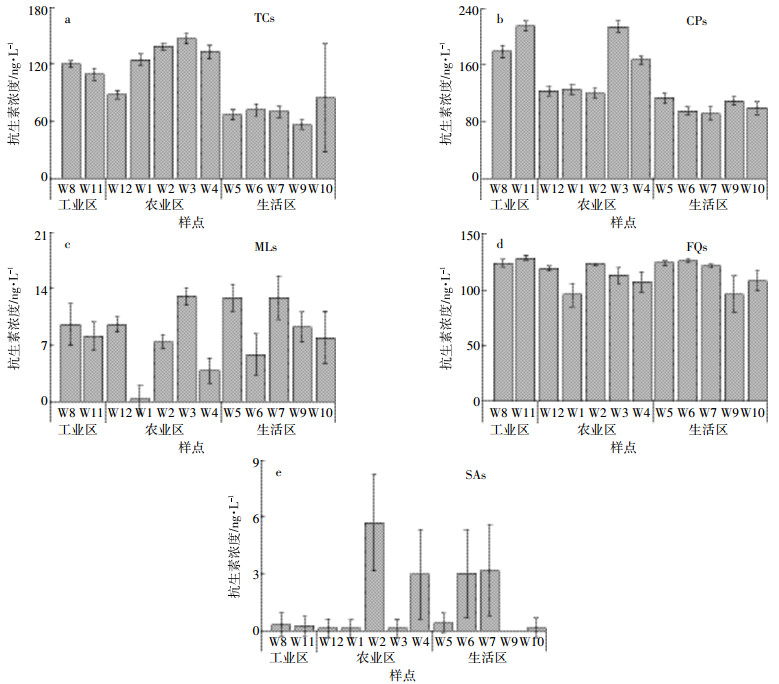
|
| 图 2 芦江流域五类抗生素浓度分布 Figure 2 The distribution of antibiotics concentrations in Lujiang River |
综上所述, 芦江流域5类抗生素均受到季节变化的影响, 并且在地域空间上表现出不同的分布特征。大部分抗生素主要集中在城市化程度低的农业区和工业区, 少部分集中在城市化程度高的生活区。研究结果表明, 芦江流域抗生素污染主要来源可能是生活污水和工业废水, 以及农业废水。
2.3 芦江流域抗生素的风险评估水环境中一般存在多种抗生素, 已有研究表明, 当多种抗生素共存时, 会增强抗生素对环境的危害作用[43-44]。对于水环境中残留药物的生态风险, 本研究以欧盟环境风险评价方法中的风险商法(RQ)对环境生态风险程度进行评估[22]。
 (1)
(1)  (2)
(2)  (3)
(3) 式中:MEC为污染物实际检测的浓度, ng·L-1; PNEC为预测无效应浓度; LC50为半致死浓度; EC50为半最大效应浓度, ng·L-1, LC50, EC50由文献中取得, 存在多值时, 取最小值; 当采用急性毒性L(E)C50数据时, AF取1000;当采用慢性NOEC数据时, AF取100;RQi为抗生素i的RQ值。采用Hernando等[45]的研究结论, 当0.01 ≤ RQ ≤ 0.10时为低风险; 0.10 ≤ RQ ≤ 1.00时为中风险; RQ ≥ 1.00时为高风险。
芦江流域生态风险商评估结果见图 3。结果表明, 所检测出的14种抗生素处于高风险等级、中等风险等级、低风险等级和无风险等级的比例为5:3:3:3。这与辽河流域[41]和三峡水库[42]的生态风险研究结果类似。CFC、NFC、OFC、EFC、LCM 5种抗生素处于高等级风险, 表明它们对芦江流域水生生物构成严重的威胁。尤其是FQs(CFC、NFC、OFC、EFC)抗生素对水生生物的毒性作用较强, 高浓度时会对生物体蓝藻、藻类等水生植物产生急性毒性, 低浓度时会对无脊椎动物和鱼类产生慢性毒害。LFC、ATM、CPC处于中等风险, 表明它们对芦江流域敏感型生物存在一定的威胁。CTC、TC和SGD三种抗生素对芦江流域生物威胁不显著。PFC和TPC两种抗生素在整个流域内都处于无风险状态, 对生态环境无潜在危险。SDZ在不同样点呈不同生态风险状态, 在W2点处于高风险状态, 在W4、W6、W7点处于中风险状态, 在其余8个样点为无风险状态。综上所述, 有50.0%以上的抗生素都达到了中等风险, 生态风险显著。与国内外研究对比, FQs抗生素浓度较低, 但其在生态风险评估中仍具有较高的风险, 表明低浓度的抗生素也会对生态环境造成一定的危害。
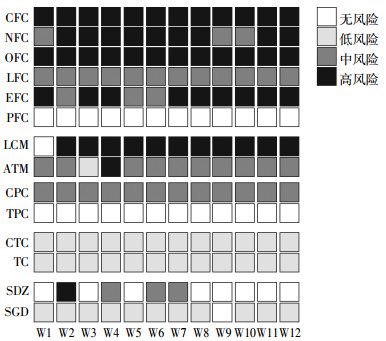
|
| 图 3 五类抗生素在12个地表水样点的风险状态 Figure 3 The risk diagram of five types of antibiotics on 12 surface water samples |
(1) 芦江流域中共检出了14种目标抗生素, 其中TCs类2种, CPs类2种, MLs类2种, SAs类2种, FQs类6种。TCs和CPs是芦江流域主要的两类抗生素, 检出率分别为96.9%、86.5%, 检出最高浓度分别为133.0、219.0 ng·L-1。FQs抗生素检出率高但检出浓度低, 检出率和检出最高浓度分别为88.9%和39.90 ng·L-1。其他两类抗生素的检出率和检出平均浓度相对较低。与国内外其他河流相比, 芦江流域抗生素浓度处于低水平。
(2) 季节变化上, 芦江流域春季和秋季抗生素检出率高于夏季和冬季。SAs和MLs抗生素浓度在四季变化大, TCs、CPs和FQs抗生素浓度在四季变化小。空间分布上, 芦江流域中TCs、CPs和FQs抗生素主要集中在城市化程度低的农业区和工业区, 表明这三类抗生素与农业和工业污染源紧密相关; MLs和SAs抗生素主要集中在城市化程度高的生活区, 其污水主要为生活污水, 污染来源为生活源。结果表明, 城市化程度较低的农业区抗生素浓度要高于城市化程度较高的工业区和生活区。
(3) 风险评估结果表明, 芦江流域中有5种抗生素具有高风险, 3种抗生素处于中等风险, 其他6种抗生素处于低风险或无风险等级。芦江流域中FQs抗生素浓度处于低水平, 但其在风险评估中有较高的风险, 表明水体中低浓度的抗生素仍有可能对生态环境造成一定的危害。
致谢 感谢 Faith Chan 博士对英文摘要的润色。| [1] |
陈治. 抗生素滥用造成的危害及其合理利用[J]. 中山大学研究生学刊(自然科学、医学版), 2013, 34(1): 21-26. CHEN Zhi. The damage caused by the antibiotic abuse and the suggestion of rational use[J]. Journal of the Graduates Sun Yat-Sen University(Natural Science, Medicine), 2013, 34(1): 21-26. |
| [2] |
Zhang Q Q, Ying G G, Pan C G, et al. A comprehensive evaluation of antibiotics emission and fate in the river basins of China:Source analysis, multimedia modelling, and linkage to bacterial resistance[J]. Environment science & Technology, 2015, 49(11): 6772-6782. |
| [3] |
Kummerer K. Antibiotics in the aquatic environment:A review-Part Ⅰ[J]. Chemosphere, 2009, 75(4): 417-434. DOI:10.1016/j.chemosphere.2008.11.086 |
| [4] |
Zhu Y G, Johnson T A, Su J Q, et al. Diverse and abundant antibiotic resistance genes in Chinese swine farms[J]. Proceedings of the National Academy of Sciences of the United States of America, 2013, 110(9): 3435-3440. DOI:10.1073/pnas.1222743110 |
| [5] |
朱婷婷, 宋战锋, 段标标, 等. 深圳石岩水库抗生素污染特征与健康风险初步评价[J]. 环境与健康杂志, 2013, 30(11): 107-110. ZHU Ting-ting, SONG Zhan-feng, DUAN Biao-biao, et al. Research on pollution and health risk by antibiotics in source water of Shiyan Reservoir in Shenzhen[J]. Journal of Environment and Health, 2013, 30(11): 107-110. |
| [6] |
Kolpin D W, Furlong E T, Meyer M T, et al. Pharmaceuticals, hormones, and other organic wastewater contaminants in US streams, 1999-2000:A national reconnaissance[J]. Environmental Science & Technology, 2002, 36(6): 1202-1211. |
| [7] |
Watkinson A J, Murby E J, Kolpin D W, et al. The occurrence of antibiotics in an urban watershed:From wastewater to drinking water[J]. Science of the Total Environment, 2009, 407(8): 2711-2723. DOI:10.1016/j.scitotenv.2008.11.059 |
| [8] |
Jiang Y H, Li M X, Guo C S, et al. Distribution and ecological risk of antibiotics in a typical effluent-receiving river(Wangyang River) in North China[J]. Chemosphere, 2014, 112: 267-274. DOI:10.1016/j.chemosphere.2014.04.075 |
| [9] |
Zhang D D, Lin L F, Luo Z X, et al. Occurrence of selected antibiotics in Jiulongjiang River in various seasons, South China[J]. Journal of Environmental Monitoring, 2011, 13(7): 1953-1960. DOI:10.1039/c0em00765j |
| [10] |
Sun Q, Li Y, Li M Y, et al. PPCPs in Jiulong River estuary(China):Spatiotemporal distributions, fate, and their use as chemical markers of wastewater[J]. Chemosphere, 2016, 150: 596-604. DOI:10.1016/j.chemosphere.2016.02.036 |
| [11] |
Yang J F, Ying G G, Zhao J L, et al. Spatial and seasonal distribution of selected antibiotics in surface waters of the Pearl Rivers, China[J]. Journal of Environmental Science and Health Part B-Pesticides Food Contaminants and Agricultural Wastes, 2011, 46(3): 272-280. DOI:10.1080/03601234.2011.540540 |
| [12] |
武旭跃, 邹华, 朱荣, 等. 太湖贡湖湾水域抗生素污染特征分布和生态风险评价[J]. 环境科学, 2016, 37(12): 4596-4604. WU Xu-yue, ZOU Hua, ZHU Rong, et al. Occurrence, distribution and ecological risk of antibiotics in surface water of the Gonghu Bay, Taihu Lake[J]. Environment Science, 2016, 37(12): 4596-4604. |
| [13] |
Jiang L, Hu X L, Yin D Q, et al. Occurrence, distribution and seasonal variation of antibiotics in the Huangpu River, Shanghai, China[J]. Chemosphere, 2011, 82(6): 822-828. DOI:10.1016/j.chemosphere.2010.11.028 |
| [14] |
Xu W H, Zhang G, Zou S C, et al. A preliminary investigation on the occurrence and distribution of antibiotics in the Yellow River and its tributaries, China[J]. Water Environment Research, 2009, 81(3): 248-254. DOI:10.2175/106143008X325719 |
| [15] |
Yan C X, Yang Y, Zhou J L, et al. Antibiotics in the surface water of the Yangtze Estuary:Occurrence, distribution and risk assessment[J]. Environmental Pollution, 2013, 175: 22-29. DOI:10.1016/j.envpol.2012.12.008 |
| [16] |
Xu Y, Guo C S, Luo Y, et al. Occurrence and distribution of antibiotics, antibiotic resistance genes in the urban rivers in Beijing, China[J]. Environmental Pollution, 2016, 213: 833-840. DOI:10.1016/j.envpol.2016.03.054 |
| [17] |
Wang Z, Zhang X H, Huang Y, et al. Comprehensive evaluation of pharmaceuticals and personal care products(PPCPs) in typical highly urbanized regions across China[J]. Environmental Pollution, 2015, 204: 223-232. DOI:10.1016/j.envpol.2015.04.021 |
| [18] |
Chen H, Li X J, Zhu S C. Occurrence and distribution of selected pharmaceuticals and personal care products in a aquatic environments:A comparative study of regions in China with different urbanization levels[J]. Environmental Science and Pollution Research, 2012, 19(6): 2381-2389. DOI:10.1007/s11356-012-0750-2 |
| [19] |
中华人民共和国国家统计局. 中国统计年鉴2011[DB/OL]. [2017-11-27]. http://www.stats.gov.cn/tjsj/ndsj/2011/indexch.htm. National Bureau of Statistics of the People's Republic of China: China statistical yearbook[DB/OL]. [2017-11-27]. http://www.stats.gov.cn/tjsj/ndsj/2011/indexch.htm. |
| [20] |
李嘉, 张瑞杰, 王润梅, 等. 小清河流域抗生素污染分布特征和生态风险评估[J]. 农业环境科学学报, 2016, 35(7): 1384-1391. LI Jia, ZHANG Rui-jie, WANG Run-mei, et al. Distribution characteristics and ecological risk assessment of antibiotic pollution in Xiaoqing River watershed[J]. Journal of Agro-Environment Science, 2016, 35(7): 1384-1391. DOI:10.11654/jaes.2016.07.022 |
| [21] |
Kim S C, Carlson K. Temporal and spatial trends in the occurrence of human and veterinary antibiotics in aqueous and river sediment matrices[J]. Environmental Science & Technology, 2007, 41(1): 50-57. |
| [22] |
赵腾辉, 陈奕涵, 韩巍, 等. 东江上游典型抗生素污染特征及生态风险评价[J]. 生态环境学报, 2016, 25(10): 1707-1713. ZHAO Teng-hui, CHEN Yi-han, HAN Wei, et al. The contamination characteristics and ecological risk assessment of typical antibiotics in the upper reaches of the Dongjiang River[J]. Ecology and Environmental Sciences, 2016, 25(10): 1707-1713. |
| [23] |
Sun Q, Lv M, Hu A Y, et al. Seasonal variation in the occurrence and removal of pharmaceuticals and personal care products in a wastewater treatment plant in Xiamen, China[J]. Journal of Hazardous Materials, 2014, 277: 69-75. DOI:10.1016/j.jhazmat.2013.11.056 |
| [24] |
Dai G H, Wang B, Fu C C, et al. Pharmaceuticals and personal care products(PPCPs) in urban and suburban rivers of Beijing, China:Occurrence, source apportionment and potential ecological risk[J]. Environmental Science-processes & Impacts, 2016, 18(4): 445-455. |
| [25] |
Zhang H, Du M M, Jiang H Y, et al. Occurrence, seasonal variation and removal efficiency of antibiotics and their metabolites in wastewater treatment plants, Jiulongjiang River Basin, South China[J]. Environmental Science-Processes & Impacts, 2015, 17(1): 225-234. |
| [26] |
Luo Y, Xu L, Rysz M, et al. Occurrence and transport of tetracycline, sulfonamide, quinolone, and macrolide antibiotics in the Haihe River Basin, China[J]. Environmental Science & Technology, 2011, 45(5): 1827-1833. |
| [27] |
Yang L, He J T, Su S H, et al. Occurrence, distribution, and attenuation of pharmaceuticals and personal care products in the riverside groundwater of the Beiyun River of Beijing, China[J]. Environmental Science and Pollution Research, 2017, 24(18): 15838-15851. DOI:10.1007/s11356-017-8999-0 |
| [28] |
Chen H X, Chen H, Ying J, et al. Dispersive liquid-liquid microextraction followed by high-performance liquid chromatography as an efficient and sensitive technique for simultaneous determination of chloramphenicol and thiamphenicol in honey[J]. Analytica Chimica Acta, 2009, 632(1): 80-85. DOI:10.1016/j.aca.2008.10.068 |
| [29] |
Gantverg A, Shishani I, Hoffman M. Determination of chloramphenicol in animal tissues and urine-liquid chromatography-tandem mass spectrometry versus gas chromatography-mass spectrometry[J]. Analytica Chimica Acta, 2003, 483(1/2): 125-135. |
| [30] |
Xu W H, Zhang G, Zou S C, et al. Determination of selected antibiotics in the Victoria Harbour and the Pearl River, South China using high-performance liquid chromatography-electrospray ionization tandem mass spectrometry[J]. Environmental Pollution, 2007, 145(3): 672-679. DOI:10.1016/j.envpol.2006.05.038 |
| [31] |
Doll T E, Frimmel F H. Fate of pharmaceuticals-photodegradation by simulated solar UV-light[J]. Chemosphere, 2003, 52(10): 1757-1769. DOI:10.1016/S0045-6535(03)00446-6 |
| [32] |
Lunestad B T, Samuelsen O B, Fjelde S, et al. Photostability of eight antibacterial agents in seawater[J]. Aquaculture, 1995, 134(3/4): 217-225. |
| [33] |
Castiglioni S, Bagnati R, Fanelli R, et al. Removal of pharmaceuticals in sewage treatment plants in Italy[J]. Environmental Science & Technology, 2006, 40(1): 357-363. |
| [34] |
Stepanic V, Ziher D, Gabelica M, et al. Physicochemical profile of macrolides and their comparison with small molecules[J]. European Journal of Medicinal Chemistry, 2012, 47: 462-472. DOI:10.1016/j.ejmech.2011.11.016 |
| [35] |
Murata A, Takada H, Mutoh K, et al. Nationwide monitoring of selected antibiotics:Distribution and sources of sulfonamides, trimethoprim, and macrolides in Japanese rivers[J]. Science of the Total Environment, 2011, 409(24): 5305-5312. DOI:10.1016/j.scitotenv.2011.09.014 |
| [36] |
Huang C H, Renew J E, Smeby K L, et al. Assessment of potential antibiotic contaminants in water and preliminary occurrence analysis[J]. Water Resources Update, 2001, 120: 334-342. |
| [37] |
葛林科. 水中溶解性物质对氯霉素类和氟喹诺酮类抗生素光降解的影响[D]. 大连: 大连理工大学, 2009. GE Lin-ke. Effects of aqueous dissolved matter on photodegradation of phenicol and fluoroquinolone antibiotics[D]. Dalian: Dalian University of Technology, 2009. http://cdmd.cnki.com.cn/Article/CDMD-10141-2010021300.htm |
| [38] |
Pouliquen H, Delpepee R, Larhantec-Verdier M, et al. Comparative hydrolysis and photolysis of four antibacterial agents(oxytetracycline oxolinic acid, flumequine and florfenicol) in deionised water, freshwater and seawater under abilotic conditions[J]. Aquaculture, 2007, 262(1): 23-28. DOI:10.1016/j.aquaculture.2006.10.014 |
| [39] |
Hayes J M, Eichman J, Katz T, et al. Stability of florfenicol in drinking water[J]. Journal of AOAC International, 2003, 86(1): 22-29. |
| [40] |
胡学香, 陈勇, 聂玉伦, 等. 四环素类化合物在不同光源下的光降解[J]. 环境工程学报, 2012, 6(8): 2465-2469. HU Xue-xiang, CHEN Yong, NIE Yu-lun, et al. Photodegradation of tetracyclines compound in aqueous solution under different light irradiation[J]. Chinese Journal of Environmental Engineering, 2012, 6(8): 2465-2469. |
| [41] |
秦延文, 张雷, 时瑶, 等. 大辽河表层水体典型抗生素污染特征与生态风险评价[J]. 环境科学研究, 2015, 28(3): 361-368. QIN Yan-wen, ZHANG Lei, Shi Yao, et al. Contamination characteristics and ecological risk assessment of typical antibiotics in surface water of the Daliao River, China[J]. Research of Environmental Sciences, 2015, 28(3): 361-368. |
| [42] |
封丽, 程艳茹, 封雷, 等. 三峡水库主要水域典型抗生素分布及生态风险评估[J]. 环境科学研究, 2017, 30(7): 1031-1040. FENG Li, CHENG Yan-ru, FENG Lei, et al. Distribution of typical antibiotics and ecological risk assessment in main waters of Three Gorges Reservoir area[J]. Research of Environmental Science, 2017, 30(7): 1031-1040. |
| [43] |
Cleuvers M. Mixture toxicity of the anti-inflammatory drugs diclofenac, ibuprofen, naproxen, and acetylsalicylic acid[J]. Ecotoxicology and Environmental Safety, 2004, 59(3): 309-315. DOI:10.1016/S0147-6513(03)00141-6 |
| [44] |
Cleuvers M. Aquatic ecotoxicity of pharmaceuticals including the assessment of combination effects[J]. Toxicology Letters, 2003, 142(3): 185-194. DOI:10.1016/S0378-4274(03)00068-7 |
| [45] |
Hernando M D, Mezcua M, Fernandez-Alba A R, et al. Environmental risk assessment of pharmaceutical residues in wastewater effluents, surface waters and sediments[J]. Talanta, 2006, 69(2): 334-342. DOI:10.1016/j.talanta.2005.09.037 |
 2018, Vol. 37
2018, Vol. 37





